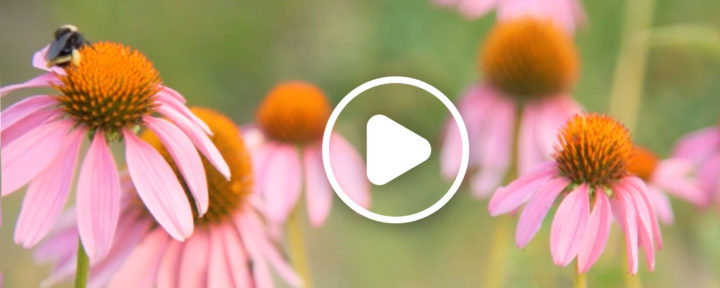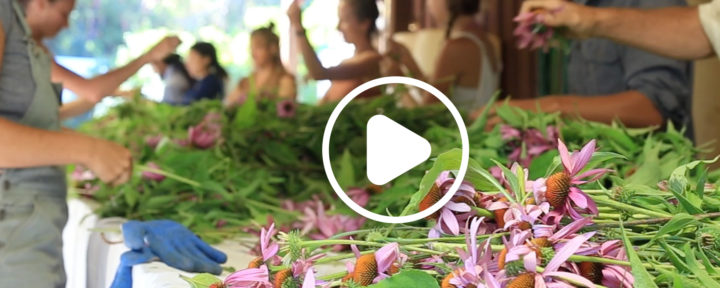Echinacea purpurea is a perennial also known as purple coneflower. It’s among 10 species of Echinacea native to North America. Echinacea’s name is rooted in the Greek word echinos, meaning “hedgehog,” a reference to the plant’s spiky, conical seed head. According to archaeological evidence, Native Americans have been using Echinacea for at least 400 years.
Echinacea is the starring ingredient in our best-selling extract Super Echinacea®. We use four parts of the plant — the root, seed, leaf and flower — to make this unique, broad-spectrum formula. To make our extract, we begin at the farm, where we consistently plant multiple small fields of Echinacea to meet our harvest goals.
Growing and harvesting Echinacea
We harvest each part of Echinacea during its peak season, when the energy is in the part we are harvesting. This helps us ensure that we are extracting each plant part when its activity is at its peak.
The first Echinacea harvest of the year is the leaf and flower, which we collect in the plants’ second year of growth. Armfuls of Echinacea are stripped of their purple flowers and coarse leaves, and their pithy stems are sent to our compost piles. The leaves and flowers are bundled and sent down the road to our processing facility, where they are tested and extracted while still fresh and succulent.
Echinacea seed is our second harvest of the year. We gather seeds from plants that have continued to flower throughout the summer. This harvest generally requires an all-crop harvester, a machine that makes quick work of separating the chaff and stem from the seed. Some smaller fields can be harvested by hand, though. After the seeds have been thoroughly cleaned, we will send them to our facility for testing and extraction. We also set aside seeds for the following year’s Echinacea crop.
Later in the fall, we head back to the Echinacea fields to harvest the roots. We give the plants at least three years before harvesting the roots, to allow ample time for them to grow. Echinacea root harvests require a tractor and digging forks. Our farm crew and interns loosen the dirt from each root ball and give them a thorough wash before chopping them into pieces. After another wash, the roots quickly make their way to our facility for testing and extraction.
Making Super Echinacea®
After the final harvest, we combine each of these extracts — that’s four different plant parts, three different harvests, over two different seasons — into one extract that we call Super Echinacea®. Extracting each of the plant parts individually allows us to provide a broad spectrum of plant compounds and the best possible representation of Echinacea purpurea.
Herb at a glance
Botanical name: Echinacea purpurea
Common name(s): Purple coneflower, Echinacea
Plant family: Asteraceae
Native habitat: Eastern and central Turkey
Parts used: roots, seeds, flowers and leaves
Botanical description: purplish-pink flowers with a spiky seed head, with narrow, dark green, lance-shaped leaves
Use(s): supports healthy function of the immune system*
Flavor profile: deep, earthy taste followed by a tingling mouthfeel due to naturally occurring alkylamides




